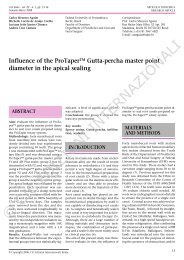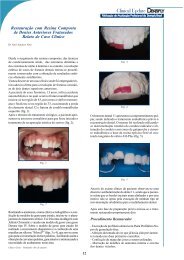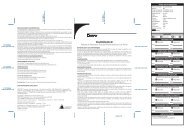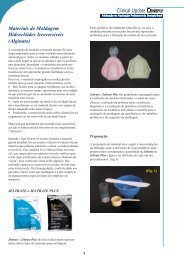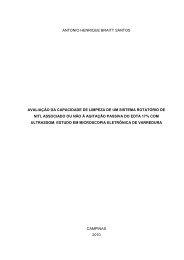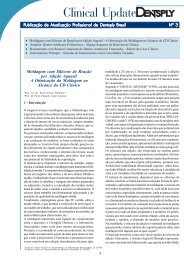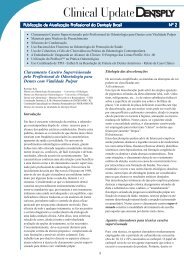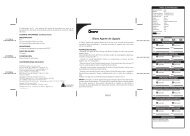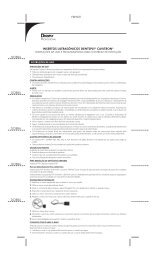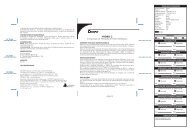You also want an ePaper? Increase the reach of your titles
YUMPU automatically turns print PDFs into web optimized ePapers that Google loves.
Braem<br />
Table 2 Results for the microshear strength (τ, MPa) and μSFR (MPa)<br />
Brand name μ-shear ± SD μSFR 25% 75% β0 1 β1 1 p-value 2 τ/μSFR<br />
strength quartile quartile (%)<br />
Fuji II LC Caps 10.1 ± 3.1 4.1 3.1 5.1 -4.5580 1.1195 0.0000 41<br />
Syntac 55.5 ± 5.1 30.4 28.4 32.4 -16.6834 0.5492 0.0000 55<br />
Optibond FL 56.9 ± 3.2 17.2 13.4 21.0 -4.9682 0.2893 0.1056 30<br />
Optibond Solo Plus 49.2 ± 10.5 11.9 9.7 14.1 -6.1994 0.5188 0.0001 24<br />
Prime & Bond NT 47.0 ± 2.7 18.3 13.9 22.7 -4.5571 0.2491 0.3987 39<br />
XP Bond 56.4 ± 2.0 30.3 26.7 33.8 -9.3190 0.3081 0.0000 52<br />
Adper ScotchBond 1 XT 51.7 ± 4.8 17.9 15.7 20.1 -8.7526 0.4895 0.0585 35<br />
Clearfil SE Bond 35.0 ± 8.4 20.7 16.4 24.9 -5.3315 0.2577 0.5672 65<br />
Clearfil Protect Bond 42.8 ± 12.3 32.6 28.9 36.3 -9.7454 0.2991 0.0000 76<br />
Xeno III 46.2 ± 3.5 25.2 25.1 25.4 -175.7207 6.9613 0.0073 55<br />
Adper Prompt-L-Pop 53.5 ± 10.7 22.7 22.5 22.9 -132.0255 5.1610 0.0585 42<br />
G-Bond 54.9 ± 3.7 15.3 8.5 22.1 -2.4908 0.1625 0.0318 28<br />
iBond 51.0 ± 8.3 12.3 8.7 15.9 -3.7347 0.3042 0.0003 24<br />
1) β0 and β1 are parameters of the logistic regression function, determining the probability of failure in terms of stress applied to the interface (S): Y = exp(β0 + β1 •S) / (1 + exp(β0 + β1 •S))<br />
2) p-value of estimate of the multiple logistic regression<br />
evance. Assuming 3 periods of 15 min of chewing per day<br />
at a chewing rate of 1 Hz, the number of chews is 2700 per<br />
day. 14 This amounts to roughly 10 6 times per year. At this frequency,<br />
a fatigue test on 1 sample takes about 12 days to<br />
accomplish 10 6 cycles. Increasing the rate to 2 Hz will offer<br />
a time-saving approach well within the frequency dependency<br />
range of the tested visco-elastic materials. Furthermore,<br />
if the noncontact events are eliminated from the<br />
chewing cycles, it can be calculated that 10 4 cycles represents<br />
about 1.2 months of continuous real-life contact. This<br />
approach is justified, since restorations tend to fail either<br />
early, before 10 4 cycles, or very late, after 10 5 cycles. 9 Moreover,<br />
a test run on a sample that does not fail now takes<br />
about 1.5 h to complete, as opposed to about 1 week for<br />
10 6 cycles.<br />
A common standard in the analysis of fatigue data is the<br />
value at which 50% of the specimens fail after a pre-set number<br />
of cycles. 2,4,5 However, in the present type of fatigue testing,<br />
considerable errors can be made as to the determination<br />
of the so-called pre-set stress levels due to geometry errors. 4<br />
Therefore, the probability of failure at each applied stress level<br />
was approximated by logistic regression where the μSFR<br />
represents the value at which 50% of the specimens fail. Calculating<br />
the 25% and 75% quartiles further illustrates the<br />
distribution of the obtained data (Table 2). It can be seen<br />
from these data that the products with the steepest slopes<br />
(β 1 ) show the lowest distribution around the μSFR.<br />
Some of the adhesives therefore show a so-called type 2<br />
fatigue behavior 10 and appear to have a rather well-defined<br />
fatigue stress level or threshold above which they fail rapidly<br />
and below which they will survive (Xeno III, Adper Prompt-<br />
L-Pop, Fuji II LC). In other products, such as G-Bond, the opposite<br />
behavior is found and a wide spread of data around<br />
the μSFR can be noted. Most of the materials show a mixed<br />
type of behavior, indicating that imperfections and defects<br />
probably determine the actual lifespan of the adhesive<br />
bond. Fractographic analysis needs to be carried out to test<br />
this hypothesis.<br />
The main advantage of the present method is that with<br />
the same setup, both shear strength and fatigue resistance<br />
can be measured and compared. It is also advantageous<br />
that the method requires no processing of the sample once<br />
the interface has been formed, thereby avoiding operator-induced<br />
defects. The results show that the μSFRs are consistently<br />
lower than the respective microshear strength for the<br />
same adhesive (Table 2). This is not surprising, since it is<br />
known that internal interfacial defects and imperfections<br />
shorten the lifespan of a joint under cyclic fatigue. Hence,<br />
fatigue data generally vary substantially more than static<br />
bond strengths. 8 The present results, however, show in<br />
some cases that the variation in the fatigue data is lower<br />
than that present in the quasi-static data, thereby emphasizing<br />
the need for nontraumatic sample preparation.<br />
It is beyond the scope of the present article to discuss in<br />
full the possible mechanism of each individual adhesive related<br />
to the measured μSFR. The present results emphasize<br />
that within each type of adhesive, products exist that show<br />
a high fatigue resistance. Furthermore, some few-step adhesives<br />
perform better than other multi-step ones, while for<br />
others it is just the opposite. Thus, not only the reduction in<br />
252 The Journal of Adhesive Dentistry



